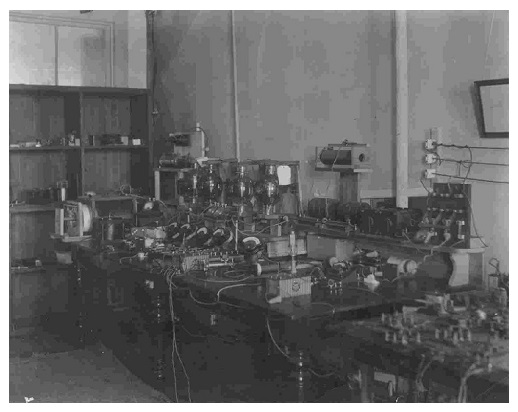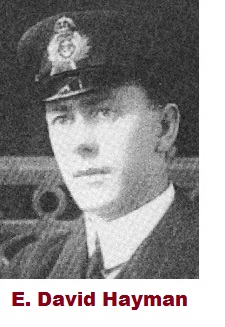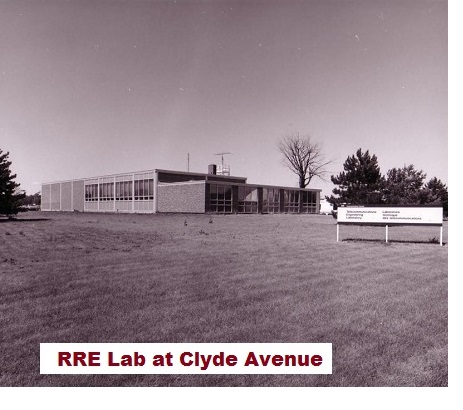
When radio first got started in Canada in the early 1900s, those working in
the new Radio Division and concerned with encouraging, facilitating and
regulating its use found that they needed a workshop for doing equipment
testing and research.
A small
vacant building was found for such a facility in Ottawa in a residential /
business area on the north side of Wellington Street near its intersection
with Kent Street.
R.O (Al) Hewitt, who grew up in that area and after the War worked in the
Marine Radio Aids Section of DOT, told me about the workshop, which at the
beginning was called the Radio Test Room. Ed Davey, who was responsible for
much of the success of DOT's Monitoring Service, mentioned the existence of
this Test Room, as the staff came to call it, in his history on the early days
of radio station monitoring in Canada.
Through its development,
construction, evaluation and maintenance of radio equipment of all kinds
during the two or so decades following World War Two, the Test Room filled a
very important role in the Radio Division's managing and facilitating the
growth of radio throughout Canada in those beginning years. What was done and
learned from the Test Room's work helped in giving technical direction and
assistance to the Division's staff across the country as they did their work.
However, that original
facility had to be moved when the Government decided in the mid '30s to level
that area in Ottawa and build new buildings for office space for the Supreme
Court of Canada and the Department of Justice. Later, during World War Two, #3
Temporary Building was built to provide office space which was occupied in
part by DOT's Air Services Branch and its Radio Division.
And so the search for a new
location began. Of course, by that time the use of radio had grown and the
number of stations and kinds of technology had increased considerably. Much
larger test and workshop facilities were absolutely necessary. The Castle
Building, then an unused grocery warehouse building at 683 Wellington Street
between the intersections of Booth and Preston Streets, seemed interesting.
With 3 large floors, a large basement and a freight elevator serving all, it
looked ideal. Further, there was a yard on the west side opening on to
Wellington Street with a platform and access door for shipping and receiving
goods by truck. Also a railway spur connected to the Canadian Pacific Broad
Street Freight Yard served a basement entrance at the back of the building.
Since it offered all that was needed, it was quickly put to use.
In a short while the new Test
Room comprised several small offices and a modest but suitably equipped
machine and construction shop on the first floor, while laboratory and work
bench facilities were distributed in several large rooms on the second floor.
The third floor was pretty well given over to storage space. The yard was also
used by staff as a place to equip vehicles with special radio equipment for
use by the Department's radio inspectors. The Test Room truck was also parked
there. The Department's Purchasing Branch kept a Stores Depot on the first
floor where the Test Room staff could purchase the materials and supplies they
needed to do their work without having to make special arrangements to buy
parts at local radio, hardware etc. stores in Ottawa.
 The Officer-in-Charge was
E. David Hayman and his staff included the
following: Jack Brooman, Jack Vincent,
Joseph Arial, Rene Arial,
Alf Lawton,
Doug Gifford, Dan MacLean, Jim Furness and Edgar Arial.
The Officer-in-Charge was
E. David Hayman and his staff included the
following: Jack Brooman, Jack Vincent,
Joseph Arial, Rene Arial,
Alf Lawton,
Doug Gifford, Dan MacLean, Jim Furness and Edgar Arial.
Direction regarding the various activities carried out by the Test Room staff
was given by the Heads of the various sections of the Radio Division
Headquarters down town. These activities included research, development,
construction, and evaluation and provision of radio equipment, described
briefly as follows:
1)
marine radio for safety and ship-shore communications and radio navigation
aids for Department ships,
2)
maintenance of the radio equipment in the coast radio stations operated by the
Canadian Marconi Company under contract with the Department,
3) radio
for aeronautical safety and air traffic control, air-ground radio
communications and for aiding air navigation,
4)
point-to-point radio communications linking district offices and isolated DOT
establishments e.g. lighthouses and arctic stations,
5) radio
facilities for canal vessel control on the Sault Ste. Marie, Welland and
Ontario - St. Lawrence Canals,
6)
control and suppression of harmful interference to the use of radio from
electric power facilities including street railways,
7)
equipping radio inspectors' vehicles for monitoring and inspection of radio
stations for compliance with license requirements and elimination of harmful
interference,
8)
examination of radio operators for certification as to qualifications to be
radio operators, and
9)
assembly of control equipment for synchronizing of marine radio beacons and
fog alarms so ships could locate themselves vis-à-vis light and fog alarm
stations.
The Department's District
Offices and their sub-offices were very well equipped to do their work and
maintain radio stations and equipment they used in their District. The only
exception involved the Quebec District where all marine radio stations along
the St. Lawrence River and Gulf and on Department ships were taken care of by
Test Room staff from Ottawa. If, in any District, radio problems of any kind
came up that could not be solved in the District they were usually referred to
Headquarters staff and the Test Room for resolution.
Shortly after the second Test Room was established, a short-wave radio
station, call sign VAA, was installed there to provide radio communications
between Headquarters and the various District Offices and Departmental radio
stations around Hudson's Bay and Hudson Strait. It was operated there until
the transmitter was moved during World War II to a new multi-purpose
transmitter site on the Greenbank Road south-west of Ottawa and the operating
position and receivers moved to the new Ottawa Monitoring Station in the
Central Experimental Farm.

This second Radio Test Room burned down in the late '60s and it was
re-established in an unused commercial Canal warehouse located in Ottawa by
the bend in the Rideau Canal near the railway Deep Cut Overpass near where
Echo Drive joined Nicholas Street. Later it was moved to a building on Bank
Street in the Glebe area of Ottawa.
The Radio Regulations Engineering Laboratory established in 1954 was not part
of the Radio Test Room. It grew out of a workshop which was part of the Ottawa
Monitoring Station and worked on equipment required for frequency and signal
strength monitoring for our monitoring stations.
The RRE Lab's job flowed from
the Department's creation of Radio Regulations Engineering, their research
needed for the development of Radio
Standards Specification governing the
technical suitability or radio equipment for licensing, and the decision to
actually test such equipment for research and/or conformity with those
standards. It was eventually moved out to the Communications Research
Centre building complex at Shirley Bay.
William J. (Bill) Wilson
Ottawa,
February 9, 2006.

